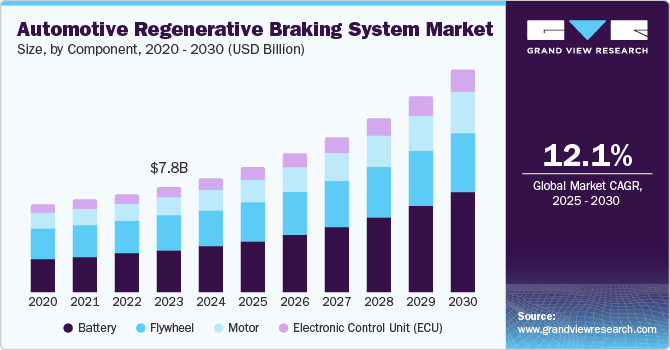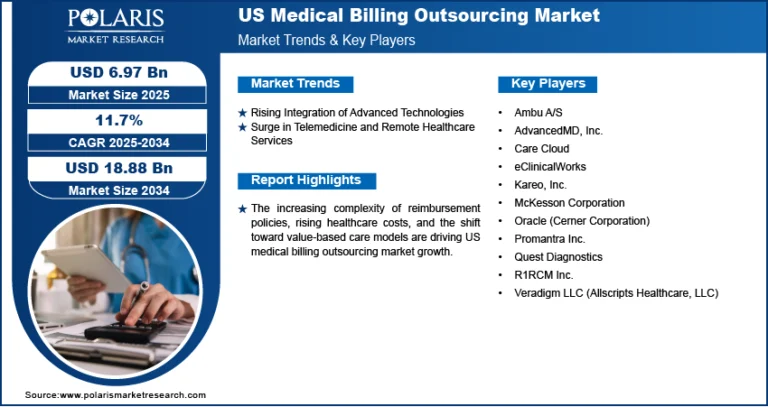Automotive Regenerative Braking System Market Size, Share & Trends Analysis growing at a CAGR of 12.1% from 2025 to 2030

The global automotive regenerative braking system market size was estimated at USD 7,825.6 million in 2024 and is projected to reach USD 15,180.9 million by 2030, growing at a CAGR of 12.1% from 2025 to 2030. The rapid growth of the electric vehicle (EV) and hybrid electric vehicle (HEV) markets is a major driver for the automotive regenerative braking system industry.
Key Market Trends & Insights
- In terms of region, Asia Pacific was the largest revenue generating market in 2024.
- Country-wise, India is expected to register the highest CAGR from 2025 to 2030.
- In terms of segment, battery accounted for a revenue of USD 3,540.4 million in 2024.
- Battery is the most lucrative component segment registering the fastest growth during the forecast period.
Market Size & Forecast
- 2024 Market Size: USD 7,825.6 Million
- 2030 Projected Market Size: USD 15,180.9 Million
- CAGR (2025-2030): 12.1%
- Asia Pacific: Largest market in 2024
Request a free sample copy or view report summary: https://www.grandviewresearch.com/industry-analysis/automotive-regenerative-braking-system-market-report/request/rs1
Regenerative braking plays a pivotal role in these vehicles by recovering and storing energy that would otherwise be wasted during braking, thus extending the range and improving fuel efficiency. As governments around the world implement stricter emission regulations and offer incentives for EV and HEV adoption, more automakers are integrating regenerative braking systems into their vehicles. This growing demand for EVs and HEVs is expected to continue fueling the market growth.
Ongoing advancements in regenerative braking technology are enhancing the efficiency of energy recovery and storage systems. Improved electric motor designs, better power electronics, and more sophisticated battery management systems are making regenerative braking systems more effective at capturing and utilizing kinetic energy. These innovations are leading to greater energy savings, longer vehicle range, and better overall vehicle performance. Thus, with the growing advancements in technology, the demand for regenerative braking systems is expected to increase in electrified vehicles.
Governments worldwide are implementing increasingly stringent emissions regulations and sustainability targets, which are encouraging automakers to adopt technologies that improve fuel efficiency and reduce carbon footprints. Regenerative braking systems, by recapturing kinetic energy and reducing the reliance on traditional braking, contribute significantly to the overall energy efficiency of vehicles. This aligns with both the automotive industry’s shift towards electrification and the global push for reducing greenhouse gas emissions. Thus, owing to the various stringent regulations, manufacturers are expected to integrate regenerative braking systems into their strategies to meet environmental targets and remain competitive in the automotive regenerative braking system industry.
Automotive regenerative braking systems offer several key benefits that contribute to enhanced vehicle performance and sustainability. By capturing and converting kinetic energy during braking into electrical energy, these systems help recharge the vehicle’s battery, improving overall energy efficiency and extending driving range, particularly in electric and hybrid vehicles. This process reduces reliance on conventional friction brakes, which lowers maintenance costs by minimizing brake wear and tear. As a result, the service life of brake components, such as discs and pads, is prolonged.
In addition, regenerative braking reduces non-exhaust emissions by lowering the need for frequent brake use, contributing to cleaner air. The system also helps mitigate heat energy dissipation, further enhancing energy conservation and reducing the environmental impact of driving. Overall, regenerative braking systems are a crucial technology for making vehicles more efficient, cost-effective, and environmentally friendly. Such benefits offered by regenerative braking systems are expected to drive their demand in the near future.





